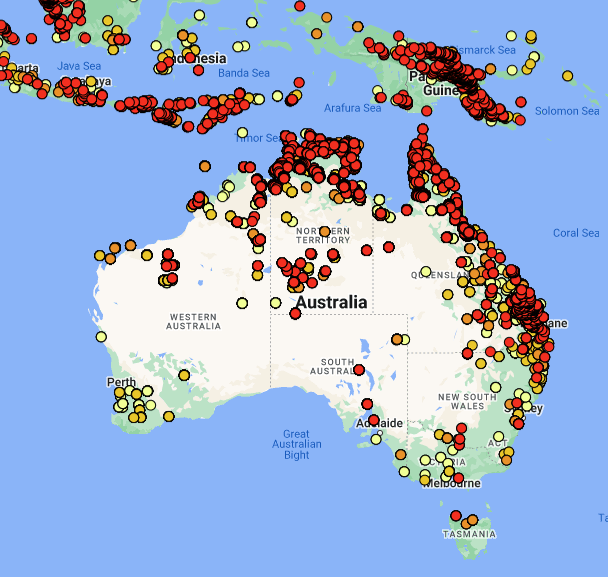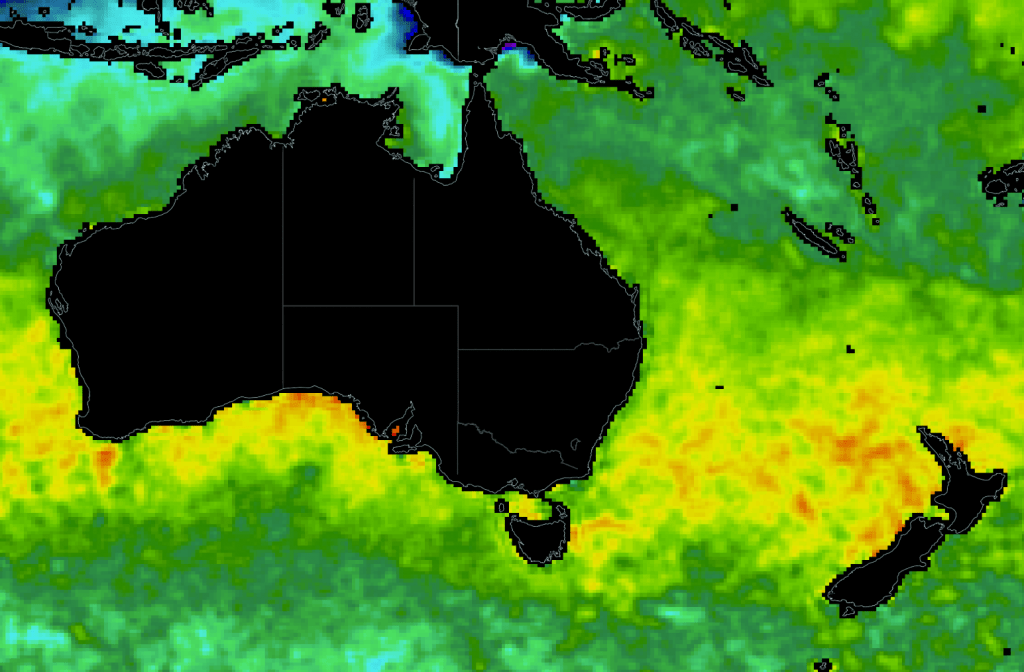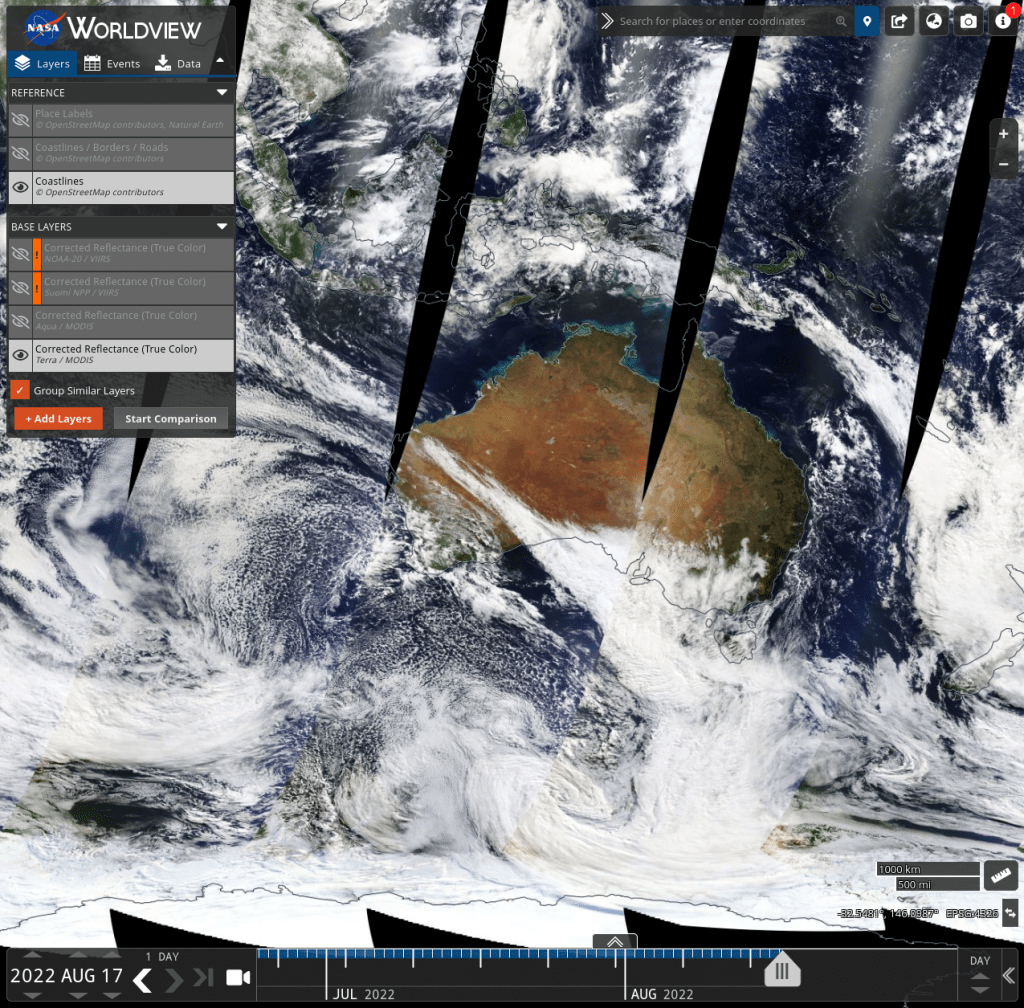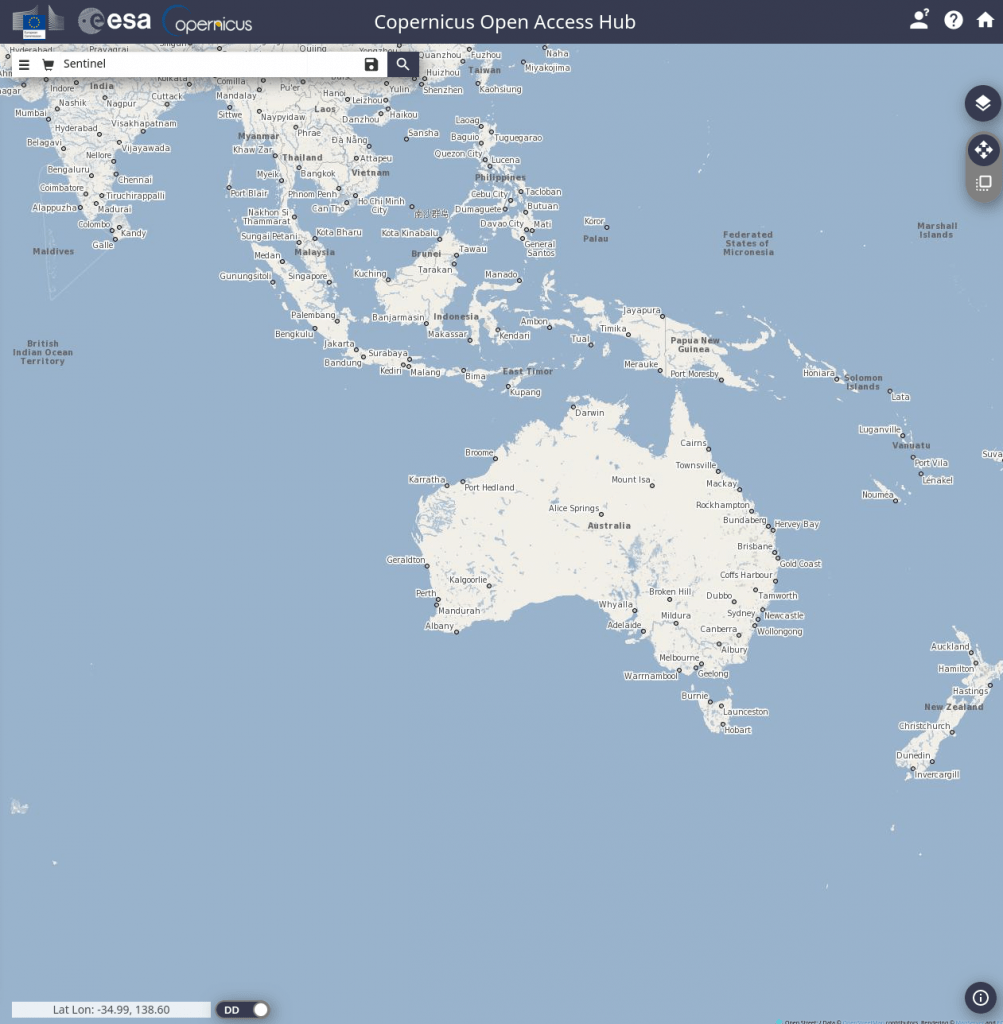
Welcome to the ASDAF Data Directory
Currently, there is a wide variety of space data available – much of which is from remote sensing, Earth observation satellites – which can be used for many different purposes. However, this data is often difficult to find; this portal aims to aggregate and categorise the major types and sources of this space data.
Earth observation space data is normally a form of light, whether visual, infrared, RADAR, or another wavelength, and is collected in ‘bands’ – sections of the electromagnetic spectrum. Depending on the amount and width of the bands, they are either known as ‘multispectral’ (a few wide bands) or ‘hyperspectral’ (many thin bands).
Once collected, these raw ‘low-level’ bands can be processed into ‘higher-level’ products to determine things such as the amount of trees in an area, particle concentrations in the air, or the make-up of the oceans.
The Basics
All space data takes some understanding of GIS (Geographic Information Systems) but even a novice can make use of some resources.
The best starting point would be the portals National Map, DEA Maps, or NASA’s Worldview; each gives an interactive view of Australia. Upon launching the portal’s web page, click the ‘help’ button.
Those already familiar with GIS data are invited to use our lists of open data by industry use or by source.
Happy searching!
Agriculture
Soil Moisture

“Root Zone Soil Moisture 9km” from 2022-07 via NASA Worldview
This is a measure of the total amount of water in the top level of soil; when gathered by satellite it is typically obtained via radar.
Relevant data is available from:
Vegetation Health/Cover

“Vegetation Index 14 Day Terra-MODIS” from 2022-07-26 via NASA Worldview
This is a measure of a given area’s vegetation cover and the health of that vegetation. It is typically presented as a fraction of the amount of Green light relative to Red or Blue.
Relevant data is available from:
- Fractional Cover by DEA from DEA Maps
- NDVI from BOM Australian Gridded Climate Data
- NDVI from NASA Worldview
Forestry
Above Ground Biomass

“Aboveground Biomass Density Mean” from 2019-2021 via NASA Worldview
This is an estimate of the total density of organic matter in a given region.
The “Aboveground Biomass Density Mean” comes from the Version 2 release of the Global Elevation Dynamics Investigation (from 2019-04-18 to 2021-08-04).
Above ground biomass is available from:
Illegal Deforestation

“Tree Cover Loss” (>30%) via Global Forest Watch
This is a detection of large-scale changes to the amount of trees in protected areas over time. This can be done with both optical and radar-based imagery.
Relevant data is available from:
- Global Forest watch
- Analysis using Sentinel 1, Sentinel 2, or Landsat imagery
Fire Detection and Historical Fire Mapping

Landgate FireWatch from 2022-08-16.
This is a map of current fires and historically burnt areas. It is often a combination of remote sensing, aerial, and in-situ data.
[Not to be used for the preservation of life or property]
Relevant data is available from:
- Landgate FireWatch
- State/Territory emergency warning services
- Analysis of Landsat, Sentinel 1&2 imagery with the Normalised Burn Ratio (dNBR)
Forest Canopy Height

“Forrest Canopy Height 2020” via NASA Worldview
This is a measure of the average height of the canopy in a given area.
The image to the left was measured by the Global Ecosystem Dynamics Investigation, a partnership between NASA and the University of Maryland.
Relevant data is available from:
Soil Moisture

“Root Zone Soil Moisture 9km” from 2022-07 via NASA Worldview
This is a measure of the total amount of water in the top level of soil; when gathered by satellite it is typically obtained via radar.
Relevant data is available from:
Vegetation Health/Cover

“Vegetation Index 14 Day Terra-MODIS” from 2022-07-26 via NASA Worldview
This is a measure of a given area’s vegetation cover and the health of that vegetation. It is typically presented as a fraction of the amount of Green light relative to Red or Blue.
Relevant data is available from:
- Fractional Cover by DEA from DEA Maps
- NDVI from BOM Australian Gridded Climate Data
- NDVI from NASA Worldview
Fishing/Aquaculture
Ocean Surface Temperature

“Ocean Surface Temperature Monthly Mean” from 2022-06 via NASA Worldview
These are satellite-derived maps of the water temperature close to the ocean’s surface.
Relevant data is available from:
Sea Surface Salinity

“Sea Surface Salinity 8-day Mean SMAP” via NASA Worldview
These are satellite-derived maps of the salinity of ocean water. Designated by EUMETSAT as an Essential Climate Variable, sea surface salinity plays a fundamental role in global ocean circulation, the water cycle, and the climate in general.
Relevant data is available from:
Diffuse Attenuation Coefficient

“Diffuse Attenuation Coefficient” from 2022-03. Sentinel 3 Data (ESA) via NASA OceanColorWeb
This is a indicator of turbidity/sediment levels via the diffuse attenuation coefficient (often called KD490). It correlates with how strongly light at 490nm is attenuated (reduced) as it passes through the water column.
Relevant data is available from:
- Sentinel Australia Regional Access (SARA) ( Sentinel 3)
- NASA’s Ocean Biology Processing Group (MODIS, S3, VIIRS, MERIS, OCTS, )
- NCI Thredds [1 FR RR] [2] (S3, MODIS, VIIRS, MERIS, SeaWiFS)
- IMOS AODN (MODIS, VIIRS)
- NASA Worldview (MODIS, VIIRS)
- EUMETSAT (Sentinel 3)
- Copernicus Open Access Hub (Sentinel 3)
Ocean Chlorophyll Index

“Ocean Chlorophyll Monthly Aggregate” from 2022-03. Sentinel 3 Data (ESA) via NASA OceanColorWeb
This is an indicator of the amount of chlorophyll pigments in the ocean. This in turn indicates the amount of phytoplankton, small photosynthetic organisms, in the ocean.
Relevant data is available from:
- Sentinel Australia Regional Access (SARA) ( Sentinel 3)
- NASA’s Ocean Biology Processing Group (MODIS, S3, VIIRS, MERIS, OCTS, )
- IMOS AODN (MODIS, VIIRS)
- NCI Thredds [1 FR RR] [2] (S3, MODIS, VIIRS, MERIS, SeaWiFS)
- NASA Worldview (MODIS, VIIRS)
- EUMETSAT (Sentinel 3)
- Copernicus Open Access Hub (Sentinel 3)
Government/Urban Planning
Fire Detection and Historical Fire Mapping

Landgate FireWatch from 2022-08-16.
This is a map of current fires and historically burnt areas. It is often a combination of remote sensing, aerial, and in-situ data.
[Not to be used for the preservation of life or property]
Relevant data is available from:
- Landgate FireWatch
- State/Territory emergency warning services
- Analysis of Landsat, Sentinel 1&2 imagery with the Normalised Burn Ratio (dNBR)
Illegal Deforestation

“Tree Cover Loss” (>30%) via Global Forest Watch
This is a detection of large-scale changes to the amount of trees in protected areas over time. This can be done with both optical and radar-based imagery.
Relevant data is available from:
- Global Forest watch
- Analysis using Sentinel 1, Sentinel 2, or Landsat imagery
Mining
Surface Mineral Index
This is an indicator of the concentration of particular surface minerals across the continent. Many minerals were mapped by the ASTER mission (NASA & METI).
Types of mineral concentration maps from the ASTER mission include:
- Gypsum
- Silica
- Quartz
- Ferrous Iron
- Ferric Oxide
- Kaolin Group
- AlOH Group
- MgOH Group
Relevant data is available from:
Access via a Web-Based Graphical User Interface with Integrated Tools
Digital Earth Australia

A display of DEA Maps GUI showing the 2021 Fractional Cover over south-west Western Australia
Digital Earth Australia (DEA) is a an initiative by Geoscience Australia, an agency of the Australian Government. It creates free and open satellite data products for Australia.
DEA services include many of their pre-processed, higher level products, such as:
- Surface reflectance
- Fractional vegetation and ground cover
- Coastlines
- Water observations
In addition to creating and curating data products, they maintain several tools, which are listed below.
A graphical map with their pre-processed, higher level products.
A catalogue of data, featuring multiple access methods (download via DEA Maps, direct file access, or using their DEA ODC Python Sandbox)
DEA’s Open Data Cube (ODC) Sandbox
DEA’s ODC Sandbox is a cloud-based sandbox with a custom Python environment. It provides access to Python tools and in-house data through Geoscience Australia’s Open Data Cube Python library.
The NASA EOSDIS Worldview GUI

The NASA EOSDIS Worldview GUI showing ‘Corrected MODIS-Terra Reflectance’ for 2022-08-17
NASA’s Earth Observing System Data and Information System (EOSDIS) provides a platform to load, visualise and interact with space data from multiple sources.
Search functions allow the addition or removal of information layers, and for data from different times to be searched through.
The National Map

The National Map interface showing DEA Waterbodies in NSW
The National Map is an Australian portal for easily accessing data from different federal, state, and local government departments directly (normally accessed via data.gov.au). This includes some satellite remote sensing data, but also many other types of GIS data. The datasets available relate to areas including:
- Agriculture
- Communications
- Elevation (eg DEM grids)
- Energy
- Reserves
- Borders
- Urban Infrastructure
- Land Cover & Use
- Satellite Images
- ABS Data
- Water
- State Government Data
- Local Government Data
Access to data via the web
The Australian Ocean Data Network

The Australian Ocean Data Network Portal
The Australian Ocean Data Network Portal gives access to ocean data from around Australia. This includes both satellite derived remote sensing data, as well as in-situ measurements. Satellites include MODIS-Aqua, NOAA, SNPP-VIIRS, Sentinel, and Orbview.
Data.gov.au

The main portal for data.gov.au
Data.gov.au is a repository of open Australian government data, including some remote sensing data.
It also has API access.
The ESA Copernicus Hub

ESA Copernicus’s Open Access Hub Portal
ESA Copernicus’s Open Access Hub (previously known as the Sentinel Scientific Data Hub) provides access to data from Sentinel missions (currently, Sentinel 1, 2, 3, 4, and 5P). This data is usually the same as that provided by SARA.
The main drawback is that many of the data products regarding Australia are “offline” – in long-term data storage and must be ordered online (usually freely) for access. For Australasian data, it is much better to use SARA.
Geophysical Archive Data Delivery System (GADDS)

The GADDS Portal
GADDS is web portal for downloading the geophysical data used in geophysical exploration. It includes elevation, gravity, magnetic, and radiometric data. While not strictly space data, it has been included here due to the adjacency of Geoscience Australia to space data and this data’s importance to geophysical exploration.
The NASA Open Data Portal

NASA’s Open Data Portal
NASA’s Open Data Portal contains data sets from a variety of remote sensing missions, as well as non-GIS data, such as information from sensors on board the International Space Station.
The SARA Application Programming Interface
SARA (Sentinel Australasia Regional Access) allows for API access for their Sentinel products. This includes a Python command line tool, which uses an underlying REST API.
API Description page available here.
Python command line tool Available here.
API Access to Data
The SARA Application Programming Interface
SARA (Sentinel Australasia Regional Access) allows for API access for their Sentinel products. This includes a Python command line tool, which uses an underlying REST API.
API Description page available here.
Python command line tool Available here.
Direct API access to ESA data through their servers.
ESA API Hub
Data.gov.au

The main portal for data.gov.au
Data.gov.au is a repository of open Australian government data, including some remote sensing data.
It also has API access.
Explore Other Resources
Data sets, and incubator and accelerator programs are now available to Australian SMEs and researchers.
Explore a non-exhaustive list of freely available Australian-based drone-based resources.
Use our recommendation tool to find relevant datasets and explore different data platforms for seamless integration and analysis.





